Finance Report: EOQ, Payback Period, Financial Statement Analysis
VerifiedAdded on 2023/01/05
|15
|4387
|63
Report
AI Summary
This report provides a comprehensive overview of key financial concepts, including Economic Order Quantity (EOQ) calculations for hard plastic, total annual cost analysis, and a critical evaluation of EOQ as an inventory management technique. It also explores payback period calculations and accounting rate of return, offering a critical assessment of the ARR method and recommendations to a senior team. Furthermore, the report delves into financial statement analysis, examining various financial ratios and emphasizing the importance of such analysis. It concludes with a discussion on the role of organizations in managing accounting standards and the function of audit committees in corporate governance. The report uses Touchdown Sports Inc. as a case study to apply the concepts discussed.
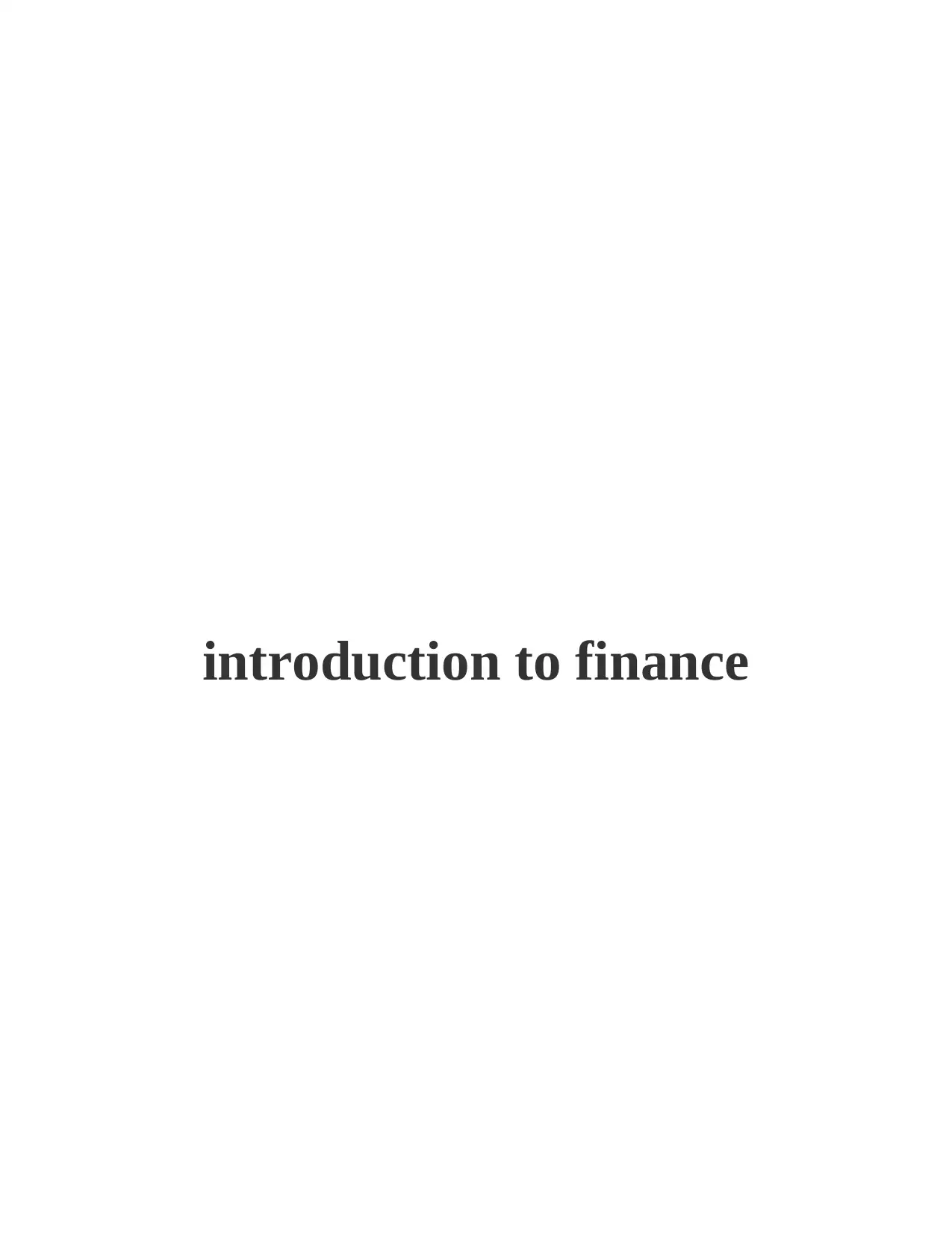
introduction to finance
Paraphrase This Document
Need a fresh take? Get an instant paraphrase of this document with our AI Paraphraser
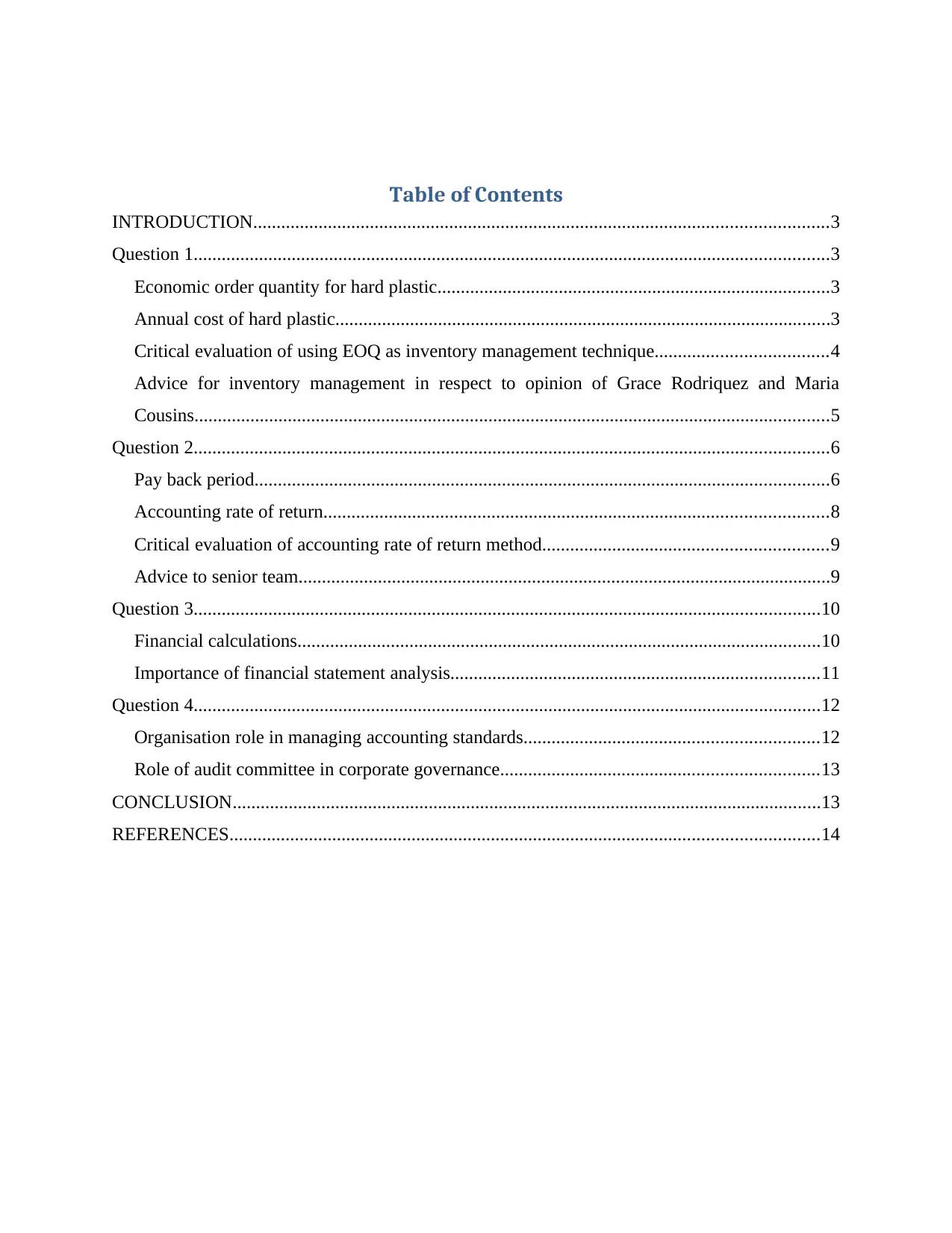
Table of Contents
INTRODUCTION...........................................................................................................................3
Question 1........................................................................................................................................3
Economic order quantity for hard plastic....................................................................................3
Annual cost of hard plastic..........................................................................................................3
Critical evaluation of using EOQ as inventory management technique.....................................4
Advice for inventory management in respect to opinion of Grace Rodriquez and Maria
Cousins........................................................................................................................................5
Question 2........................................................................................................................................6
Pay back period...........................................................................................................................6
Accounting rate of return............................................................................................................8
Critical evaluation of accounting rate of return method.............................................................9
Advice to senior team..................................................................................................................9
Question 3......................................................................................................................................10
Financial calculations................................................................................................................10
Importance of financial statement analysis...............................................................................11
Question 4......................................................................................................................................12
Organisation role in managing accounting standards...............................................................12
Role of audit committee in corporate governance....................................................................13
CONCLUSION..............................................................................................................................13
REFERENCES..............................................................................................................................14
INTRODUCTION...........................................................................................................................3
Question 1........................................................................................................................................3
Economic order quantity for hard plastic....................................................................................3
Annual cost of hard plastic..........................................................................................................3
Critical evaluation of using EOQ as inventory management technique.....................................4
Advice for inventory management in respect to opinion of Grace Rodriquez and Maria
Cousins........................................................................................................................................5
Question 2........................................................................................................................................6
Pay back period...........................................................................................................................6
Accounting rate of return............................................................................................................8
Critical evaluation of accounting rate of return method.............................................................9
Advice to senior team..................................................................................................................9
Question 3......................................................................................................................................10
Financial calculations................................................................................................................10
Importance of financial statement analysis...............................................................................11
Question 4......................................................................................................................................12
Organisation role in managing accounting standards...............................................................12
Role of audit committee in corporate governance....................................................................13
CONCLUSION..............................................................................................................................13
REFERENCES..............................................................................................................................14
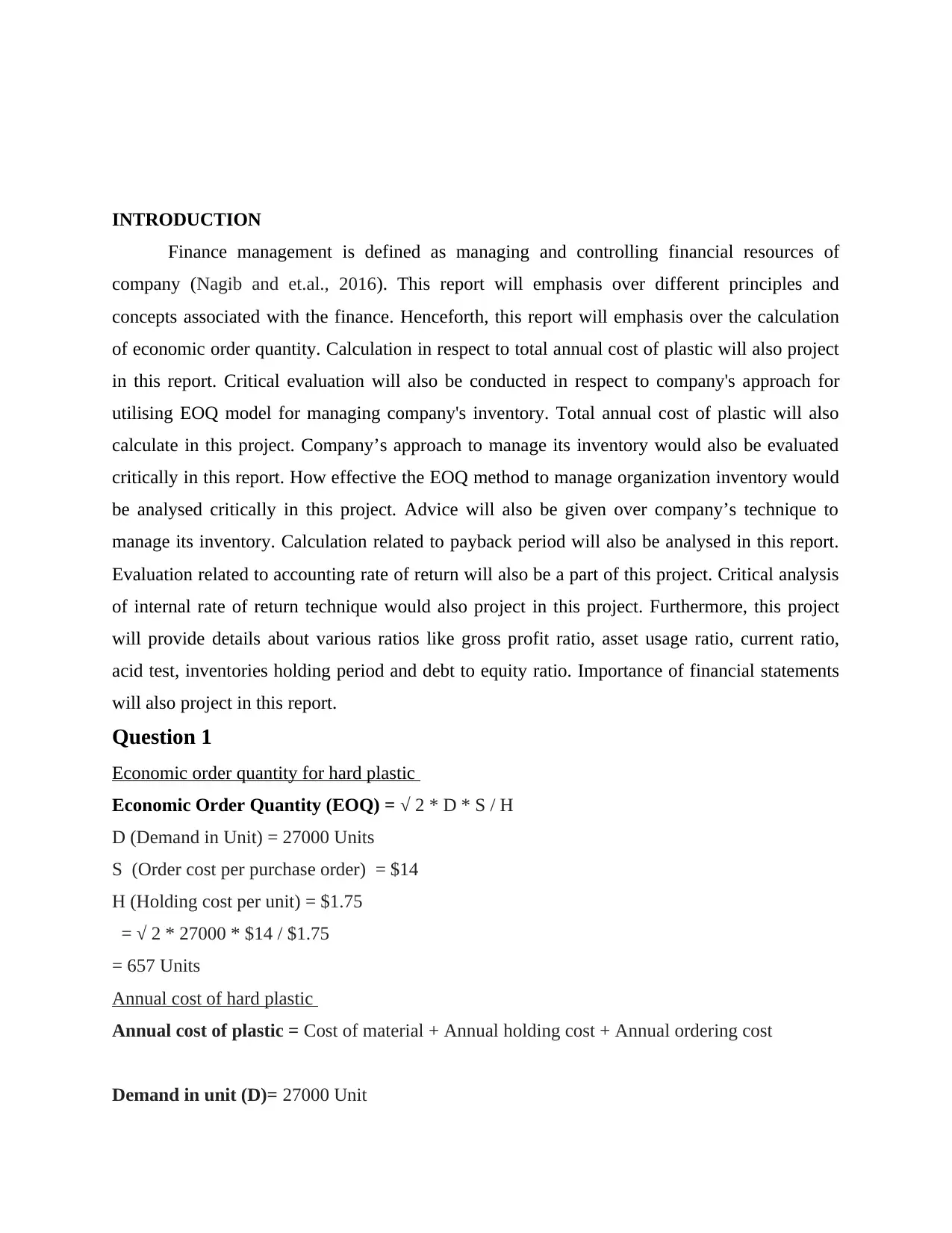
INTRODUCTION
Finance management is defined as managing and controlling financial resources of
company (Nagib and et.al., 2016). This report will emphasis over different principles and
concepts associated with the finance. Henceforth, this report will emphasis over the calculation
of economic order quantity. Calculation in respect to total annual cost of plastic will also project
in this report. Critical evaluation will also be conducted in respect to company's approach for
utilising EOQ model for managing company's inventory. Total annual cost of plastic will also
calculate in this project. Company’s approach to manage its inventory would also be evaluated
critically in this report. How effective the EOQ method to manage organization inventory would
be analysed critically in this project. Advice will also be given over company’s technique to
manage its inventory. Calculation related to payback period will also be analysed in this report.
Evaluation related to accounting rate of return will also be a part of this project. Critical analysis
of internal rate of return technique would also project in this project. Furthermore, this project
will provide details about various ratios like gross profit ratio, asset usage ratio, current ratio,
acid test, inventories holding period and debt to equity ratio. Importance of financial statements
will also project in this report.
Question 1
Economic order quantity for hard plastic
Economic Order Quantity (EOQ) = √ 2 * D * S / H
D (Demand in Unit) = 27000 Units
S (Order cost per purchase order) = $14
H (Holding cost per unit) = $1.75
= √ 2 * 27000 * $14 / $1.75
= 657 Units
Annual cost of hard plastic
Annual cost of plastic = Cost of material + Annual holding cost + Annual ordering cost
Demand in unit (D)= 27000 Unit
Finance management is defined as managing and controlling financial resources of
company (Nagib and et.al., 2016). This report will emphasis over different principles and
concepts associated with the finance. Henceforth, this report will emphasis over the calculation
of economic order quantity. Calculation in respect to total annual cost of plastic will also project
in this report. Critical evaluation will also be conducted in respect to company's approach for
utilising EOQ model for managing company's inventory. Total annual cost of plastic will also
calculate in this project. Company’s approach to manage its inventory would also be evaluated
critically in this report. How effective the EOQ method to manage organization inventory would
be analysed critically in this project. Advice will also be given over company’s technique to
manage its inventory. Calculation related to payback period will also be analysed in this report.
Evaluation related to accounting rate of return will also be a part of this project. Critical analysis
of internal rate of return technique would also project in this project. Furthermore, this project
will provide details about various ratios like gross profit ratio, asset usage ratio, current ratio,
acid test, inventories holding period and debt to equity ratio. Importance of financial statements
will also project in this report.
Question 1
Economic order quantity for hard plastic
Economic Order Quantity (EOQ) = √ 2 * D * S / H
D (Demand in Unit) = 27000 Units
S (Order cost per purchase order) = $14
H (Holding cost per unit) = $1.75
= √ 2 * 27000 * $14 / $1.75
= 657 Units
Annual cost of hard plastic
Annual cost of plastic = Cost of material + Annual holding cost + Annual ordering cost
Demand in unit (D)= 27000 Unit
⊘ This is a preview!⊘
Do you want full access?
Subscribe today to unlock all pages.

Trusted by 1+ million students worldwide
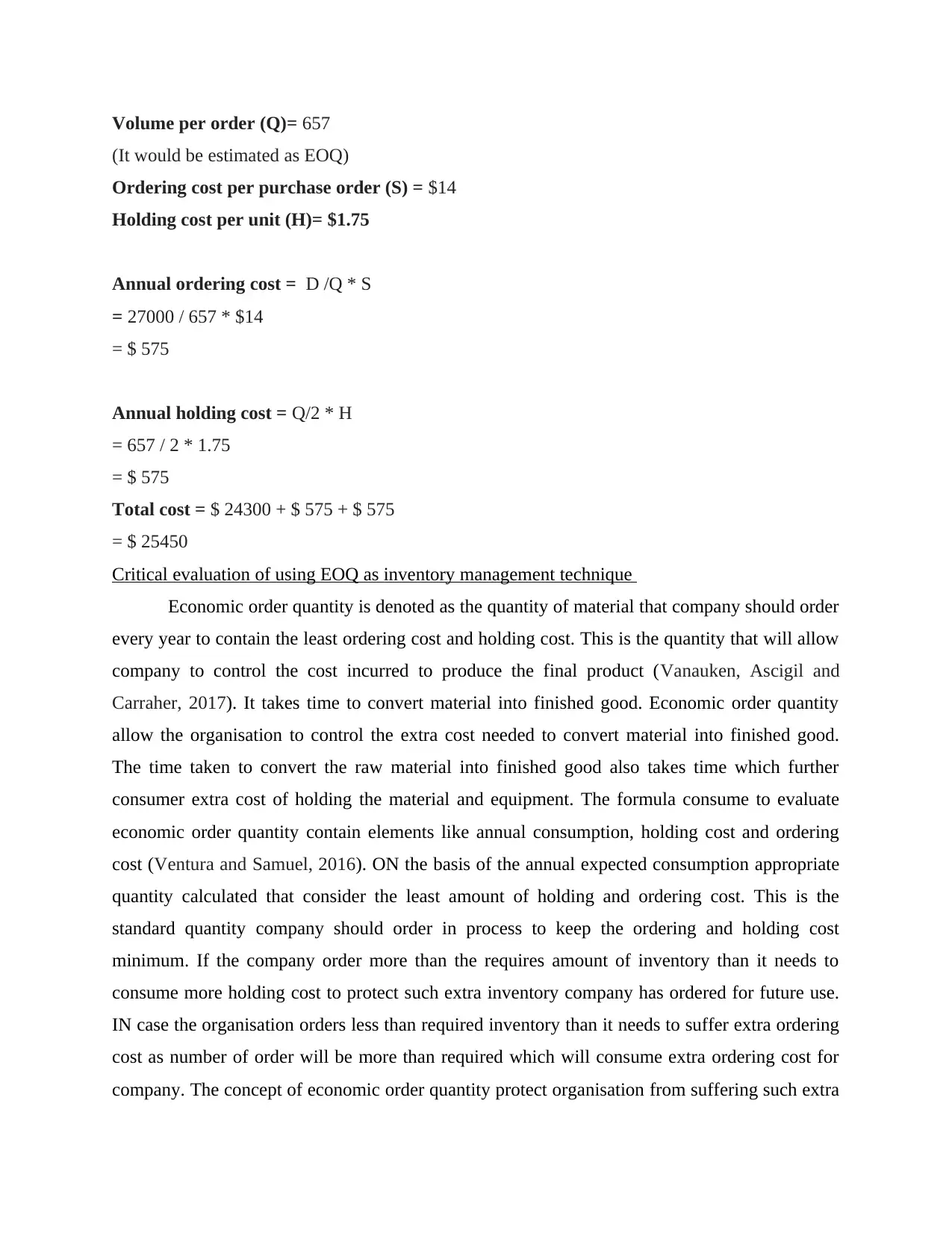
Volume per order (Q)= 657
(It would be estimated as EOQ)
Ordering cost per purchase order (S) = $14
Holding cost per unit (H)= $1.75
Annual ordering cost = D /Q * S
= 27000 / 657 * $14
= $ 575
Annual holding cost = Q/2 * H
= 657 / 2 * 1.75
= $ 575
Total cost = $ 24300 + $ 575 + $ 575
= $ 25450
Critical evaluation of using EOQ as inventory management technique
Economic order quantity is denoted as the quantity of material that company should order
every year to contain the least ordering cost and holding cost. This is the quantity that will allow
company to control the cost incurred to produce the final product (Vanauken, Ascigil and
Carraher, 2017). It takes time to convert material into finished good. Economic order quantity
allow the organisation to control the extra cost needed to convert material into finished good.
The time taken to convert the raw material into finished good also takes time which further
consumer extra cost of holding the material and equipment. The formula consume to evaluate
economic order quantity contain elements like annual consumption, holding cost and ordering
cost (Ventura and Samuel, 2016). ON the basis of the annual expected consumption appropriate
quantity calculated that consider the least amount of holding and ordering cost. This is the
standard quantity company should order in process to keep the ordering and holding cost
minimum. If the company order more than the requires amount of inventory than it needs to
consume more holding cost to protect such extra inventory company has ordered for future use.
IN case the organisation orders less than required inventory than it needs to suffer extra ordering
cost as number of order will be more than required which will consume extra ordering cost for
company. The concept of economic order quantity protect organisation from suffering such extra
(It would be estimated as EOQ)
Ordering cost per purchase order (S) = $14
Holding cost per unit (H)= $1.75
Annual ordering cost = D /Q * S
= 27000 / 657 * $14
= $ 575
Annual holding cost = Q/2 * H
= 657 / 2 * 1.75
= $ 575
Total cost = $ 24300 + $ 575 + $ 575
= $ 25450
Critical evaluation of using EOQ as inventory management technique
Economic order quantity is denoted as the quantity of material that company should order
every year to contain the least ordering cost and holding cost. This is the quantity that will allow
company to control the cost incurred to produce the final product (Vanauken, Ascigil and
Carraher, 2017). It takes time to convert material into finished good. Economic order quantity
allow the organisation to control the extra cost needed to convert material into finished good.
The time taken to convert the raw material into finished good also takes time which further
consumer extra cost of holding the material and equipment. The formula consume to evaluate
economic order quantity contain elements like annual consumption, holding cost and ordering
cost (Ventura and Samuel, 2016). ON the basis of the annual expected consumption appropriate
quantity calculated that consider the least amount of holding and ordering cost. This is the
standard quantity company should order in process to keep the ordering and holding cost
minimum. If the company order more than the requires amount of inventory than it needs to
consume more holding cost to protect such extra inventory company has ordered for future use.
IN case the organisation orders less than required inventory than it needs to suffer extra ordering
cost as number of order will be more than required which will consume extra ordering cost for
company. The concept of economic order quantity protect organisation from suffering such extra
Paraphrase This Document
Need a fresh take? Get an instant paraphrase of this document with our AI Paraphraser
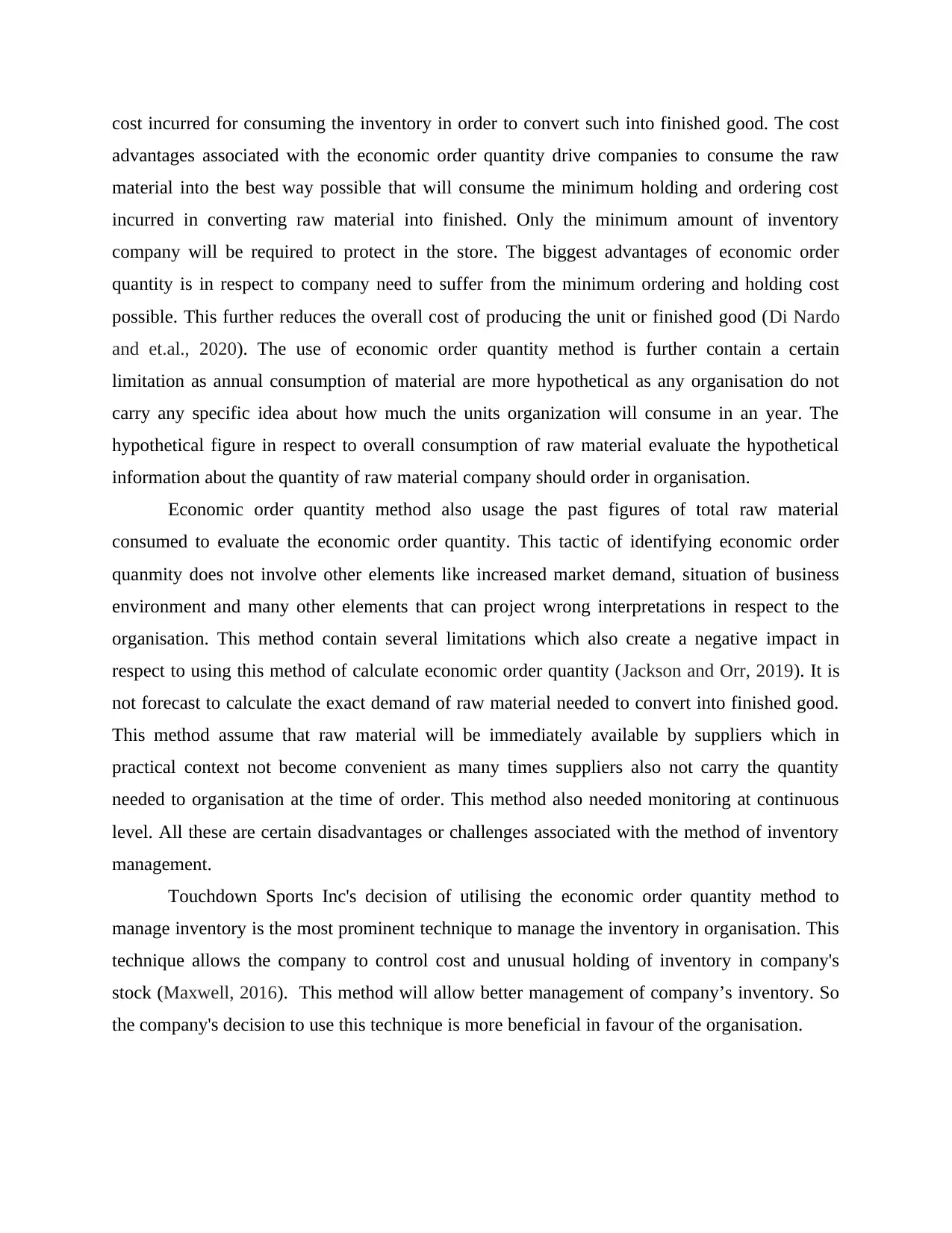
cost incurred for consuming the inventory in order to convert such into finished good. The cost
advantages associated with the economic order quantity drive companies to consume the raw
material into the best way possible that will consume the minimum holding and ordering cost
incurred in converting raw material into finished. Only the minimum amount of inventory
company will be required to protect in the store. The biggest advantages of economic order
quantity is in respect to company need to suffer from the minimum ordering and holding cost
possible. This further reduces the overall cost of producing the unit or finished good (Di Nardo
and et.al., 2020). The use of economic order quantity method is further contain a certain
limitation as annual consumption of material are more hypothetical as any organisation do not
carry any specific idea about how much the units organization will consume in an year. The
hypothetical figure in respect to overall consumption of raw material evaluate the hypothetical
information about the quantity of raw material company should order in organisation.
Economic order quantity method also usage the past figures of total raw material
consumed to evaluate the economic order quantity. This tactic of identifying economic order
quanmity does not involve other elements like increased market demand, situation of business
environment and many other elements that can project wrong interpretations in respect to the
organisation. This method contain several limitations which also create a negative impact in
respect to using this method of calculate economic order quantity (Jackson and Orr, 2019). It is
not forecast to calculate the exact demand of raw material needed to convert into finished good.
This method assume that raw material will be immediately available by suppliers which in
practical context not become convenient as many times suppliers also not carry the quantity
needed to organisation at the time of order. This method also needed monitoring at continuous
level. All these are certain disadvantages or challenges associated with the method of inventory
management.
Touchdown Sports Inc's decision of utilising the economic order quantity method to
manage inventory is the most prominent technique to manage the inventory in organisation. This
technique allows the company to control cost and unusual holding of inventory in company's
stock (Maxwell, 2016). This method will allow better management of company’s inventory. So
the company's decision to use this technique is more beneficial in favour of the organisation.
advantages associated with the economic order quantity drive companies to consume the raw
material into the best way possible that will consume the minimum holding and ordering cost
incurred in converting raw material into finished. Only the minimum amount of inventory
company will be required to protect in the store. The biggest advantages of economic order
quantity is in respect to company need to suffer from the minimum ordering and holding cost
possible. This further reduces the overall cost of producing the unit or finished good (Di Nardo
and et.al., 2020). The use of economic order quantity method is further contain a certain
limitation as annual consumption of material are more hypothetical as any organisation do not
carry any specific idea about how much the units organization will consume in an year. The
hypothetical figure in respect to overall consumption of raw material evaluate the hypothetical
information about the quantity of raw material company should order in organisation.
Economic order quantity method also usage the past figures of total raw material
consumed to evaluate the economic order quantity. This tactic of identifying economic order
quanmity does not involve other elements like increased market demand, situation of business
environment and many other elements that can project wrong interpretations in respect to the
organisation. This method contain several limitations which also create a negative impact in
respect to using this method of calculate economic order quantity (Jackson and Orr, 2019). It is
not forecast to calculate the exact demand of raw material needed to convert into finished good.
This method assume that raw material will be immediately available by suppliers which in
practical context not become convenient as many times suppliers also not carry the quantity
needed to organisation at the time of order. This method also needed monitoring at continuous
level. All these are certain disadvantages or challenges associated with the method of inventory
management.
Touchdown Sports Inc's decision of utilising the economic order quantity method to
manage inventory is the most prominent technique to manage the inventory in organisation. This
technique allows the company to control cost and unusual holding of inventory in company's
stock (Maxwell, 2016). This method will allow better management of company’s inventory. So
the company's decision to use this technique is more beneficial in favour of the organisation.

Advice for inventory management in respect to opinion of Grace Rodriquez and Maria Cousins
Inventory management is a critical aspect of business. On the basis of the annual
consumption of raw material company conduct its inventory management practices. Grace
Rodriquez and Maria Cousins suggested the just in time method of managing inventory in
organisation. This method of inventory management guides the company to order inventory only
the time when raw material are needed to organisation. The prior order of inventory are not a part
of practice if company. This method follows the practice that raw material should be ordered
only the time when it is needed in factory. This method is directed towards cost control as
keeping material in stock will occur holding cost and ordering cost. Just in time inventory
method would directly allow the company to avoid holding cost. Ordering cost will be same in
this method of inventory management. Once the stock reached the re order level inventory are
ordered in this method so at the time of actual requirement of such stock raw material is
available in stock for company (Park, Ramesh and Cao, 2016). Ordering cost can also be more
than the EOQ method of inventory management. This method would directly control or restricts
the holding cost of inventory but it will generate more ordering cost for company. This method
also contains a limitation that it is not necessary that raw material would be immediately
available with the supplier. In case due top any abnormal reason supplier could not deliver raw
material company will face a trouble in producing the finished good. This method contains extra
risk of shortage of inventory in company's stock. Economic order quantity contain both the cost
holding cost and ordering cost but in limit (Bolomope and et.al., 2020). Economic order method
also ensures the proper availability of company's stock at all the time of production even in
abnormal circumstances. All these advantages associated with the economic order quantity make
this method more beneficial in respect to the organisation. Use of economic order quantity
method is more beneficial for the organisation. This method will allow the organisation to
control both cost and time related to the management of inventory.
Question 2
Pay back period
Pay back period is defined as time taken to recover the original investment amount.
Project A
Summary of cash flow Amount ($000) Accumulated Cash Flow
Inventory management is a critical aspect of business. On the basis of the annual
consumption of raw material company conduct its inventory management practices. Grace
Rodriquez and Maria Cousins suggested the just in time method of managing inventory in
organisation. This method of inventory management guides the company to order inventory only
the time when raw material are needed to organisation. The prior order of inventory are not a part
of practice if company. This method follows the practice that raw material should be ordered
only the time when it is needed in factory. This method is directed towards cost control as
keeping material in stock will occur holding cost and ordering cost. Just in time inventory
method would directly allow the company to avoid holding cost. Ordering cost will be same in
this method of inventory management. Once the stock reached the re order level inventory are
ordered in this method so at the time of actual requirement of such stock raw material is
available in stock for company (Park, Ramesh and Cao, 2016). Ordering cost can also be more
than the EOQ method of inventory management. This method would directly control or restricts
the holding cost of inventory but it will generate more ordering cost for company. This method
also contains a limitation that it is not necessary that raw material would be immediately
available with the supplier. In case due top any abnormal reason supplier could not deliver raw
material company will face a trouble in producing the finished good. This method contains extra
risk of shortage of inventory in company's stock. Economic order quantity contain both the cost
holding cost and ordering cost but in limit (Bolomope and et.al., 2020). Economic order method
also ensures the proper availability of company's stock at all the time of production even in
abnormal circumstances. All these advantages associated with the economic order quantity make
this method more beneficial in respect to the organisation. Use of economic order quantity
method is more beneficial for the organisation. This method will allow the organisation to
control both cost and time related to the management of inventory.
Question 2
Pay back period
Pay back period is defined as time taken to recover the original investment amount.
Project A
Summary of cash flow Amount ($000) Accumulated Cash Flow
⊘ This is a preview!⊘
Do you want full access?
Subscribe today to unlock all pages.

Trusted by 1+ million students worldwide
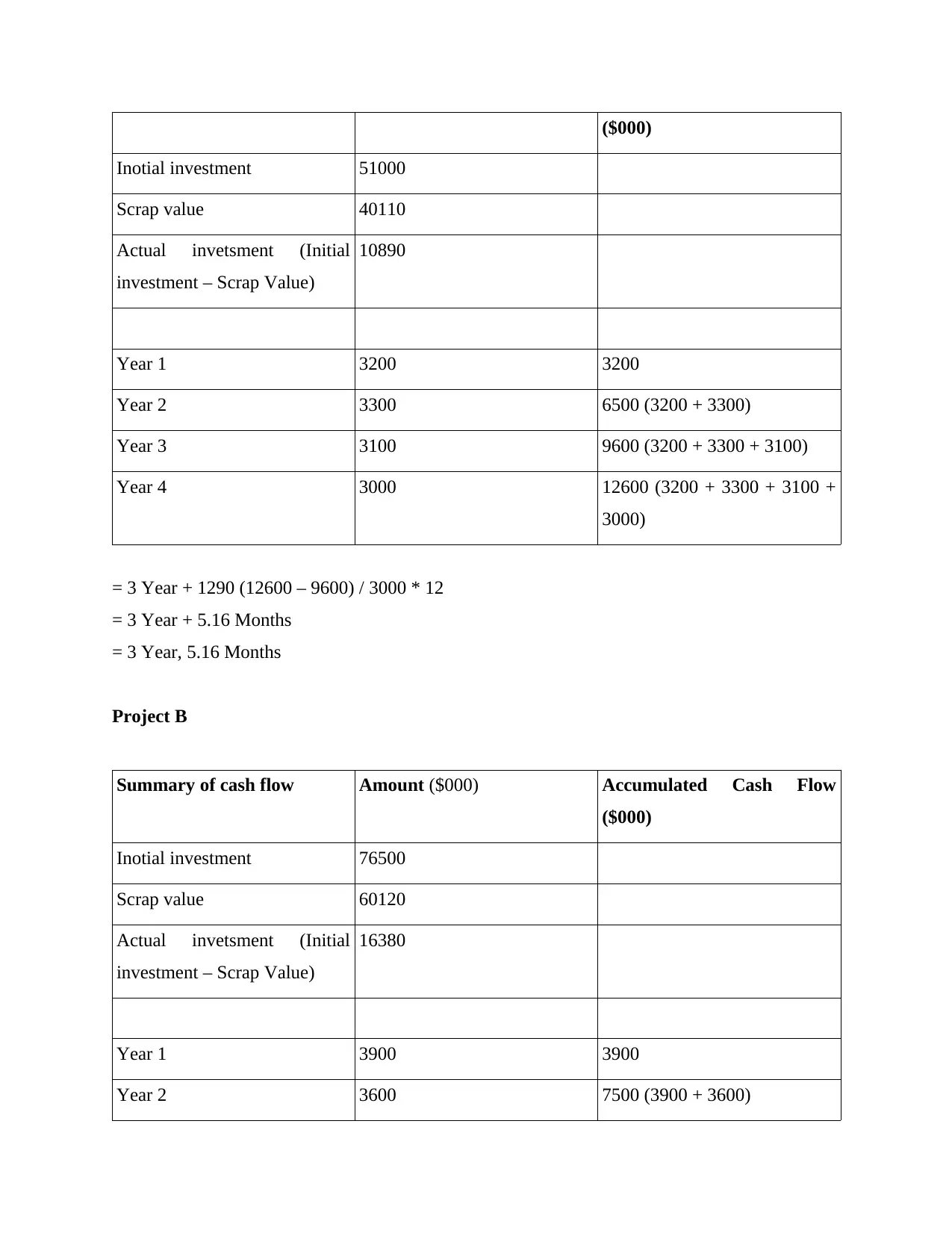
($000)
Inotial investment 51000
Scrap value 40110
Actual invetsment (Initial
investment – Scrap Value)
10890
Year 1 3200 3200
Year 2 3300 6500 (3200 + 3300)
Year 3 3100 9600 (3200 + 3300 + 3100)
Year 4 3000 12600 (3200 + 3300 + 3100 +
3000)
= 3 Year + 1290 (12600 – 9600) / 3000 * 12
= 3 Year + 5.16 Months
= 3 Year, 5.16 Months
Project B
Summary of cash flow Amount ($000) Accumulated Cash Flow
($000)
Inotial investment 76500
Scrap value 60120
Actual invetsment (Initial
investment – Scrap Value)
16380
Year 1 3900 3900
Year 2 3600 7500 (3900 + 3600)
Inotial investment 51000
Scrap value 40110
Actual invetsment (Initial
investment – Scrap Value)
10890
Year 1 3200 3200
Year 2 3300 6500 (3200 + 3300)
Year 3 3100 9600 (3200 + 3300 + 3100)
Year 4 3000 12600 (3200 + 3300 + 3100 +
3000)
= 3 Year + 1290 (12600 – 9600) / 3000 * 12
= 3 Year + 5.16 Months
= 3 Year, 5.16 Months
Project B
Summary of cash flow Amount ($000) Accumulated Cash Flow
($000)
Inotial investment 76500
Scrap value 60120
Actual invetsment (Initial
investment – Scrap Value)
16380
Year 1 3900 3900
Year 2 3600 7500 (3900 + 3600)
Paraphrase This Document
Need a fresh take? Get an instant paraphrase of this document with our AI Paraphraser
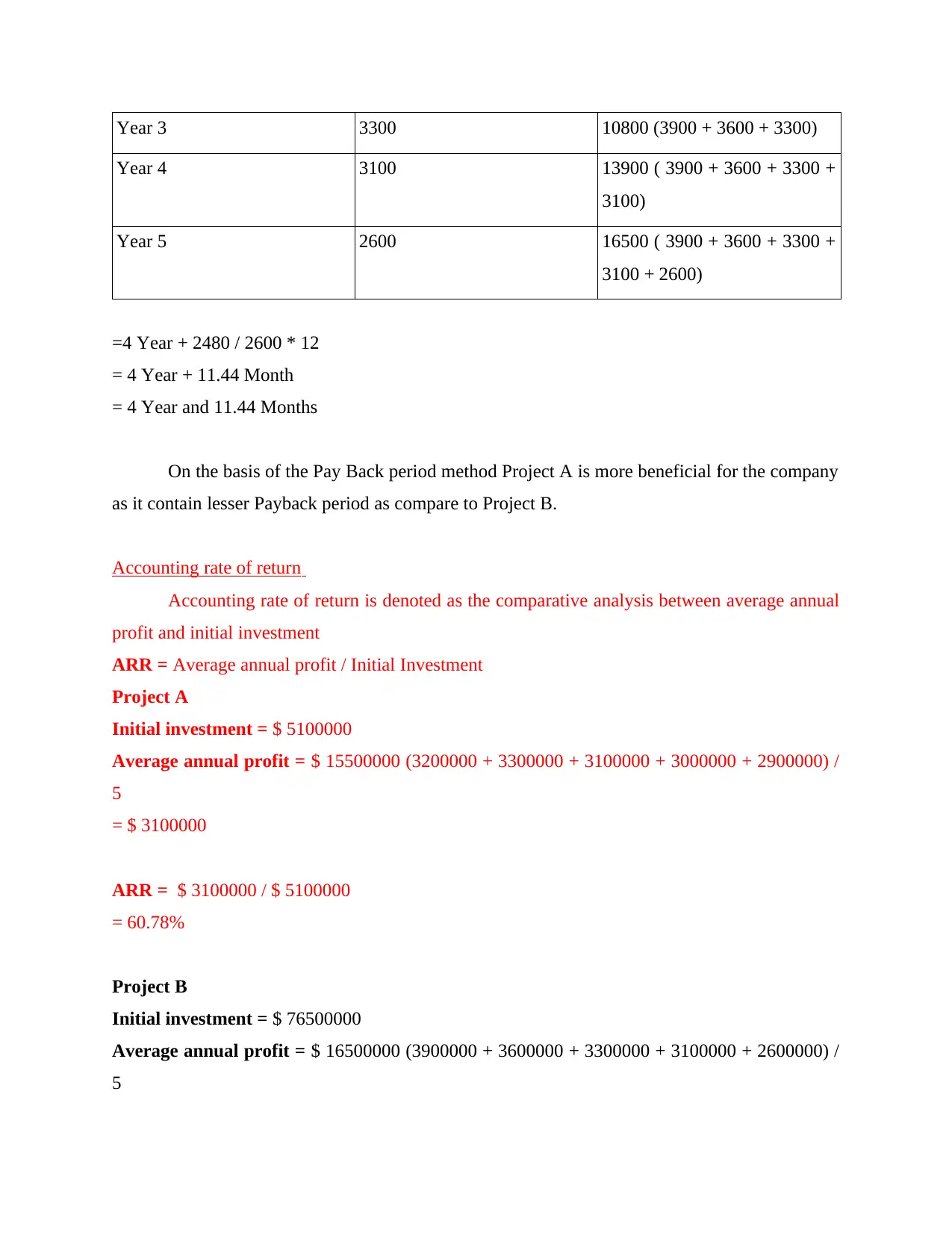
Year 3 3300 10800 (3900 + 3600 + 3300)
Year 4 3100 13900 ( 3900 + 3600 + 3300 +
3100)
Year 5 2600 16500 ( 3900 + 3600 + 3300 +
3100 + 2600)
=4 Year + 2480 / 2600 * 12
= 4 Year + 11.44 Month
= 4 Year and 11.44 Months
On the basis of the Pay Back period method Project A is more beneficial for the company
as it contain lesser Payback period as compare to Project B.
Accounting rate of return
Accounting rate of return is denoted as the comparative analysis between average annual
profit and initial investment
ARR = Average annual profit / Initial Investment
Project A
Initial investment = $ 5100000
Average annual profit = $ 15500000 (3200000 + 3300000 + 3100000 + 3000000 + 2900000) /
5
= $ 3100000
ARR = $ 3100000 / $ 5100000
= 60.78%
Project B
Initial investment = $ 76500000
Average annual profit = $ 16500000 (3900000 + 3600000 + 3300000 + 3100000 + 2600000) /
5
Year 4 3100 13900 ( 3900 + 3600 + 3300 +
3100)
Year 5 2600 16500 ( 3900 + 3600 + 3300 +
3100 + 2600)
=4 Year + 2480 / 2600 * 12
= 4 Year + 11.44 Month
= 4 Year and 11.44 Months
On the basis of the Pay Back period method Project A is more beneficial for the company
as it contain lesser Payback period as compare to Project B.
Accounting rate of return
Accounting rate of return is denoted as the comparative analysis between average annual
profit and initial investment
ARR = Average annual profit / Initial Investment
Project A
Initial investment = $ 5100000
Average annual profit = $ 15500000 (3200000 + 3300000 + 3100000 + 3000000 + 2900000) /
5
= $ 3100000
ARR = $ 3100000 / $ 5100000
= 60.78%
Project B
Initial investment = $ 76500000
Average annual profit = $ 16500000 (3900000 + 3600000 + 3300000 + 3100000 + 2600000) /
5
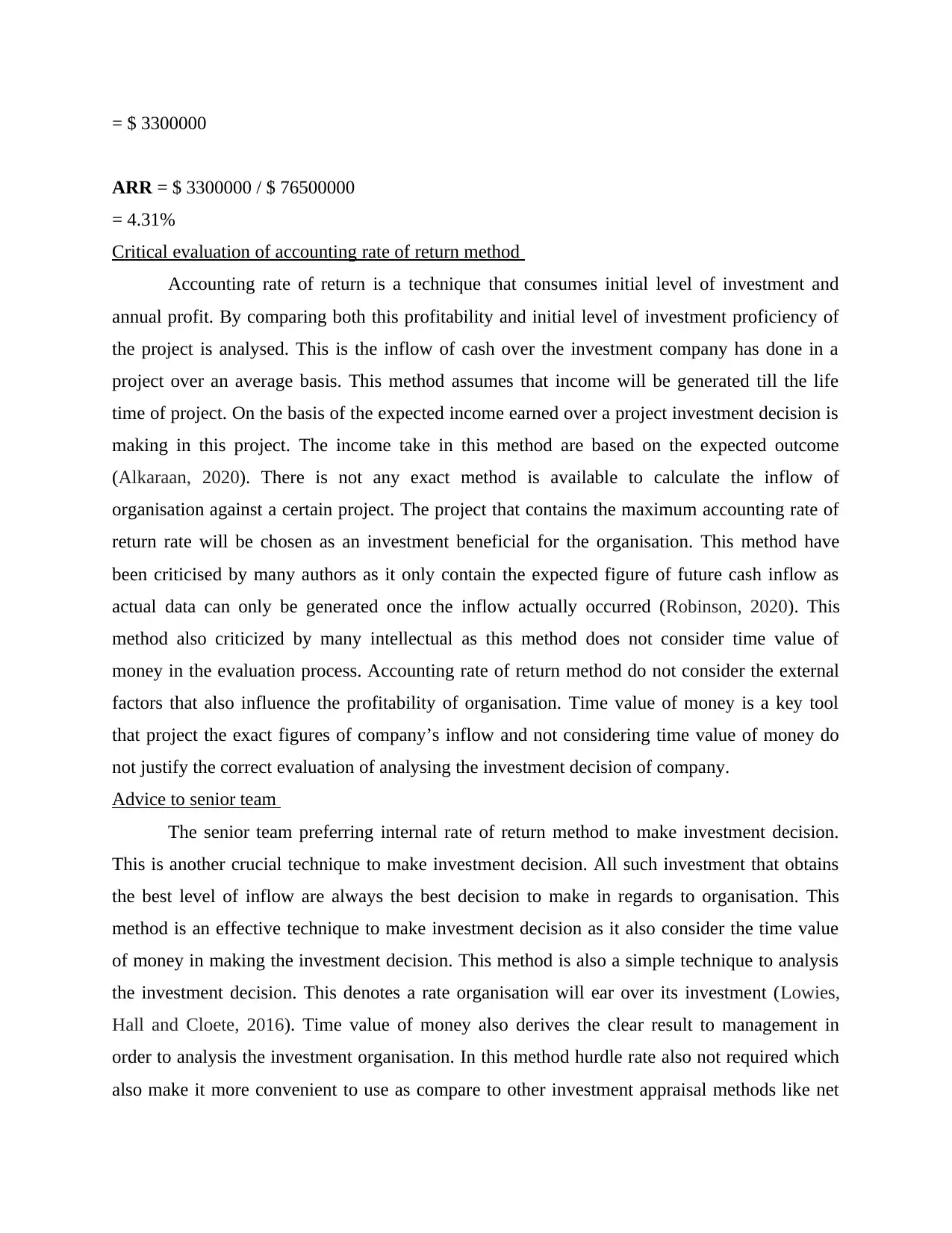
= $ 3300000
ARR = $ 3300000 / $ 76500000
= 4.31%
Critical evaluation of accounting rate of return method
Accounting rate of return is a technique that consumes initial level of investment and
annual profit. By comparing both this profitability and initial level of investment proficiency of
the project is analysed. This is the inflow of cash over the investment company has done in a
project over an average basis. This method assumes that income will be generated till the life
time of project. On the basis of the expected income earned over a project investment decision is
making in this project. The income take in this method are based on the expected outcome
(Alkaraan, 2020). There is not any exact method is available to calculate the inflow of
organisation against a certain project. The project that contains the maximum accounting rate of
return rate will be chosen as an investment beneficial for the organisation. This method have
been criticised by many authors as it only contain the expected figure of future cash inflow as
actual data can only be generated once the inflow actually occurred (Robinson, 2020). This
method also criticized by many intellectual as this method does not consider time value of
money in the evaluation process. Accounting rate of return method do not consider the external
factors that also influence the profitability of organisation. Time value of money is a key tool
that project the exact figures of company’s inflow and not considering time value of money do
not justify the correct evaluation of analysing the investment decision of company.
Advice to senior team
The senior team preferring internal rate of return method to make investment decision.
This is another crucial technique to make investment decision. All such investment that obtains
the best level of inflow are always the best decision to make in regards to organisation. This
method is an effective technique to make investment decision as it also consider the time value
of money in making the investment decision. This method is also a simple technique to analysis
the investment decision. This denotes a rate organisation will ear over its investment (Lowies,
Hall and Cloete, 2016). Time value of money also derives the clear result to management in
order to analysis the investment organisation. In this method hurdle rate also not required which
also make it more convenient to use as compare to other investment appraisal methods like net
ARR = $ 3300000 / $ 76500000
= 4.31%
Critical evaluation of accounting rate of return method
Accounting rate of return is a technique that consumes initial level of investment and
annual profit. By comparing both this profitability and initial level of investment proficiency of
the project is analysed. This is the inflow of cash over the investment company has done in a
project over an average basis. This method assumes that income will be generated till the life
time of project. On the basis of the expected income earned over a project investment decision is
making in this project. The income take in this method are based on the expected outcome
(Alkaraan, 2020). There is not any exact method is available to calculate the inflow of
organisation against a certain project. The project that contains the maximum accounting rate of
return rate will be chosen as an investment beneficial for the organisation. This method have
been criticised by many authors as it only contain the expected figure of future cash inflow as
actual data can only be generated once the inflow actually occurred (Robinson, 2020). This
method also criticized by many intellectual as this method does not consider time value of
money in the evaluation process. Accounting rate of return method do not consider the external
factors that also influence the profitability of organisation. Time value of money is a key tool
that project the exact figures of company’s inflow and not considering time value of money do
not justify the correct evaluation of analysing the investment decision of company.
Advice to senior team
The senior team preferring internal rate of return method to make investment decision.
This is another crucial technique to make investment decision. All such investment that obtains
the best level of inflow are always the best decision to make in regards to organisation. This
method is an effective technique to make investment decision as it also consider the time value
of money in making the investment decision. This method is also a simple technique to analysis
the investment decision. This denotes a rate organisation will ear over its investment (Lowies,
Hall and Cloete, 2016). Time value of money also derives the clear result to management in
order to analysis the investment organisation. In this method hurdle rate also not required which
also make it more convenient to use as compare to other investment appraisal methods like net
⊘ This is a preview!⊘
Do you want full access?
Subscribe today to unlock all pages.

Trusted by 1+ million students worldwide
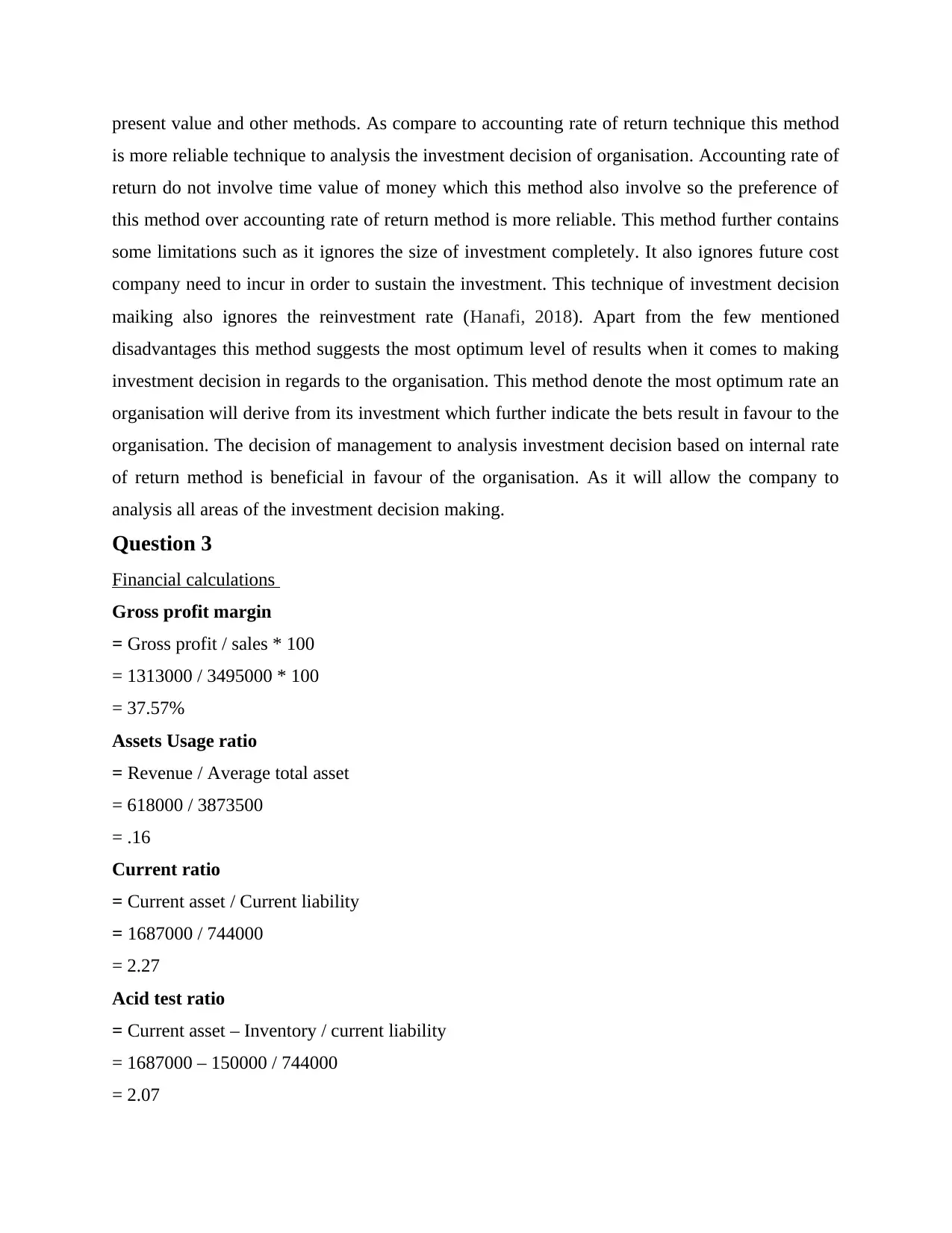
present value and other methods. As compare to accounting rate of return technique this method
is more reliable technique to analysis the investment decision of organisation. Accounting rate of
return do not involve time value of money which this method also involve so the preference of
this method over accounting rate of return method is more reliable. This method further contains
some limitations such as it ignores the size of investment completely. It also ignores future cost
company need to incur in order to sustain the investment. This technique of investment decision
maiking also ignores the reinvestment rate (Hanafi, 2018). Apart from the few mentioned
disadvantages this method suggests the most optimum level of results when it comes to making
investment decision in regards to the organisation. This method denote the most optimum rate an
organisation will derive from its investment which further indicate the bets result in favour to the
organisation. The decision of management to analysis investment decision based on internal rate
of return method is beneficial in favour of the organisation. As it will allow the company to
analysis all areas of the investment decision making.
Question 3
Financial calculations
Gross profit margin
= Gross profit / sales * 100
= 1313000 / 3495000 * 100
= 37.57%
Assets Usage ratio
= Revenue / Average total asset
= 618000 / 3873500
= .16
Current ratio
= Current asset / Current liability
= 1687000 / 744000
= 2.27
Acid test ratio
= Current asset – Inventory / current liability
= 1687000 – 150000 / 744000
= 2.07
is more reliable technique to analysis the investment decision of organisation. Accounting rate of
return do not involve time value of money which this method also involve so the preference of
this method over accounting rate of return method is more reliable. This method further contains
some limitations such as it ignores the size of investment completely. It also ignores future cost
company need to incur in order to sustain the investment. This technique of investment decision
maiking also ignores the reinvestment rate (Hanafi, 2018). Apart from the few mentioned
disadvantages this method suggests the most optimum level of results when it comes to making
investment decision in regards to the organisation. This method denote the most optimum rate an
organisation will derive from its investment which further indicate the bets result in favour to the
organisation. The decision of management to analysis investment decision based on internal rate
of return method is beneficial in favour of the organisation. As it will allow the company to
analysis all areas of the investment decision making.
Question 3
Financial calculations
Gross profit margin
= Gross profit / sales * 100
= 1313000 / 3495000 * 100
= 37.57%
Assets Usage ratio
= Revenue / Average total asset
= 618000 / 3873500
= .16
Current ratio
= Current asset / Current liability
= 1687000 / 744000
= 2.27
Acid test ratio
= Current asset – Inventory / current liability
= 1687000 – 150000 / 744000
= 2.07
Paraphrase This Document
Need a fresh take? Get an instant paraphrase of this document with our AI Paraphraser
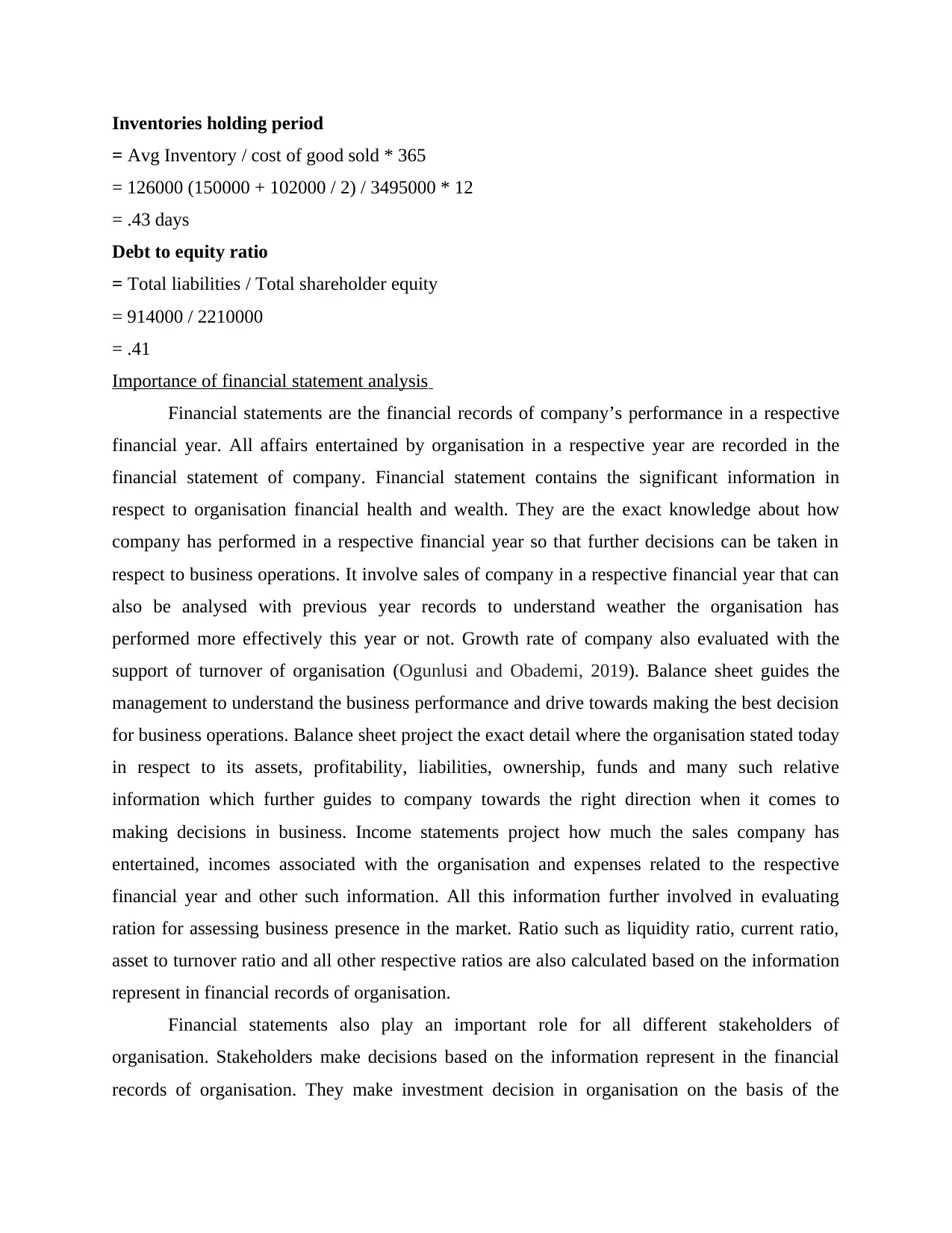
Inventories holding period
= Avg Inventory / cost of good sold * 365
= 126000 (150000 + 102000 / 2) / 3495000 * 12
= .43 days
Debt to equity ratio
= Total liabilities / Total shareholder equity
= 914000 / 2210000
= .41
Importance of financial statement analysis
Financial statements are the financial records of company’s performance in a respective
financial year. All affairs entertained by organisation in a respective year are recorded in the
financial statement of company. Financial statement contains the significant information in
respect to organisation financial health and wealth. They are the exact knowledge about how
company has performed in a respective financial year so that further decisions can be taken in
respect to business operations. It involve sales of company in a respective financial year that can
also be analysed with previous year records to understand weather the organisation has
performed more effectively this year or not. Growth rate of company also evaluated with the
support of turnover of organisation (Ogunlusi and Obademi, 2019). Balance sheet guides the
management to understand the business performance and drive towards making the best decision
for business operations. Balance sheet project the exact detail where the organisation stated today
in respect to its assets, profitability, liabilities, ownership, funds and many such relative
information which further guides to company towards the right direction when it comes to
making decisions in business. Income statements project how much the sales company has
entertained, incomes associated with the organisation and expenses related to the respective
financial year and other such information. All this information further involved in evaluating
ration for assessing business presence in the market. Ratio such as liquidity ratio, current ratio,
asset to turnover ratio and all other respective ratios are also calculated based on the information
represent in financial records of organisation.
Financial statements also play an important role for all different stakeholders of
organisation. Stakeholders make decisions based on the information represent in the financial
records of organisation. They make investment decision in organisation on the basis of the
= Avg Inventory / cost of good sold * 365
= 126000 (150000 + 102000 / 2) / 3495000 * 12
= .43 days
Debt to equity ratio
= Total liabilities / Total shareholder equity
= 914000 / 2210000
= .41
Importance of financial statement analysis
Financial statements are the financial records of company’s performance in a respective
financial year. All affairs entertained by organisation in a respective year are recorded in the
financial statement of company. Financial statement contains the significant information in
respect to organisation financial health and wealth. They are the exact knowledge about how
company has performed in a respective financial year so that further decisions can be taken in
respect to business operations. It involve sales of company in a respective financial year that can
also be analysed with previous year records to understand weather the organisation has
performed more effectively this year or not. Growth rate of company also evaluated with the
support of turnover of organisation (Ogunlusi and Obademi, 2019). Balance sheet guides the
management to understand the business performance and drive towards making the best decision
for business operations. Balance sheet project the exact detail where the organisation stated today
in respect to its assets, profitability, liabilities, ownership, funds and many such relative
information which further guides to company towards the right direction when it comes to
making decisions in business. Income statements project how much the sales company has
entertained, incomes associated with the organisation and expenses related to the respective
financial year and other such information. All this information further involved in evaluating
ration for assessing business presence in the market. Ratio such as liquidity ratio, current ratio,
asset to turnover ratio and all other respective ratios are also calculated based on the information
represent in financial records of organisation.
Financial statements also play an important role for all different stakeholders of
organisation. Stakeholders make decisions based on the information represent in the financial
records of organisation. They make investment decision in organisation on the basis of the
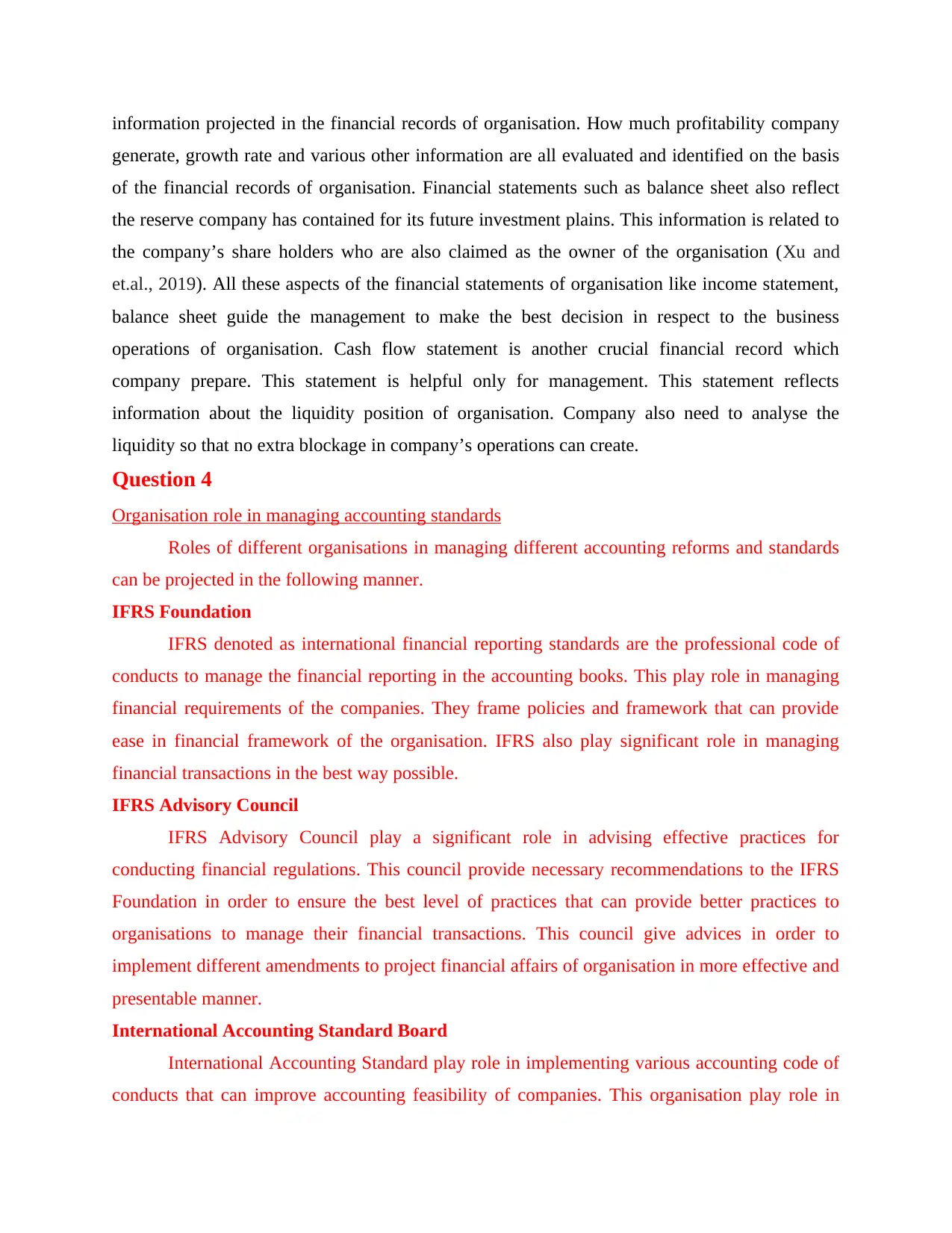
information projected in the financial records of organisation. How much profitability company
generate, growth rate and various other information are all evaluated and identified on the basis
of the financial records of organisation. Financial statements such as balance sheet also reflect
the reserve company has contained for its future investment plains. This information is related to
the company’s share holders who are also claimed as the owner of the organisation (Xu and
et.al., 2019). All these aspects of the financial statements of organisation like income statement,
balance sheet guide the management to make the best decision in respect to the business
operations of organisation. Cash flow statement is another crucial financial record which
company prepare. This statement is helpful only for management. This statement reflects
information about the liquidity position of organisation. Company also need to analyse the
liquidity so that no extra blockage in company’s operations can create.
Question 4
Organisation role in managing accounting standards
Roles of different organisations in managing different accounting reforms and standards
can be projected in the following manner.
IFRS Foundation
IFRS denoted as international financial reporting standards are the professional code of
conducts to manage the financial reporting in the accounting books. This play role in managing
financial requirements of the companies. They frame policies and framework that can provide
ease in financial framework of the organisation. IFRS also play significant role in managing
financial transactions in the best way possible.
IFRS Advisory Council
IFRS Advisory Council play a significant role in advising effective practices for
conducting financial regulations. This council provide necessary recommendations to the IFRS
Foundation in order to ensure the best level of practices that can provide better practices to
organisations to manage their financial transactions. This council give advices in order to
implement different amendments to project financial affairs of organisation in more effective and
presentable manner.
International Accounting Standard Board
International Accounting Standard play role in implementing various accounting code of
conducts that can improve accounting feasibility of companies. This organisation play role in
generate, growth rate and various other information are all evaluated and identified on the basis
of the financial records of organisation. Financial statements such as balance sheet also reflect
the reserve company has contained for its future investment plains. This information is related to
the company’s share holders who are also claimed as the owner of the organisation (Xu and
et.al., 2019). All these aspects of the financial statements of organisation like income statement,
balance sheet guide the management to make the best decision in respect to the business
operations of organisation. Cash flow statement is another crucial financial record which
company prepare. This statement is helpful only for management. This statement reflects
information about the liquidity position of organisation. Company also need to analyse the
liquidity so that no extra blockage in company’s operations can create.
Question 4
Organisation role in managing accounting standards
Roles of different organisations in managing different accounting reforms and standards
can be projected in the following manner.
IFRS Foundation
IFRS denoted as international financial reporting standards are the professional code of
conducts to manage the financial reporting in the accounting books. This play role in managing
financial requirements of the companies. They frame policies and framework that can provide
ease in financial framework of the organisation. IFRS also play significant role in managing
financial transactions in the best way possible.
IFRS Advisory Council
IFRS Advisory Council play a significant role in advising effective practices for
conducting financial regulations. This council provide necessary recommendations to the IFRS
Foundation in order to ensure the best level of practices that can provide better practices to
organisations to manage their financial transactions. This council give advices in order to
implement different amendments to project financial affairs of organisation in more effective and
presentable manner.
International Accounting Standard Board
International Accounting Standard play role in implementing various accounting code of
conducts that can improve accounting feasibility of companies. This organisation play role in
⊘ This is a preview!⊘
Do you want full access?
Subscribe today to unlock all pages.

Trusted by 1+ million students worldwide
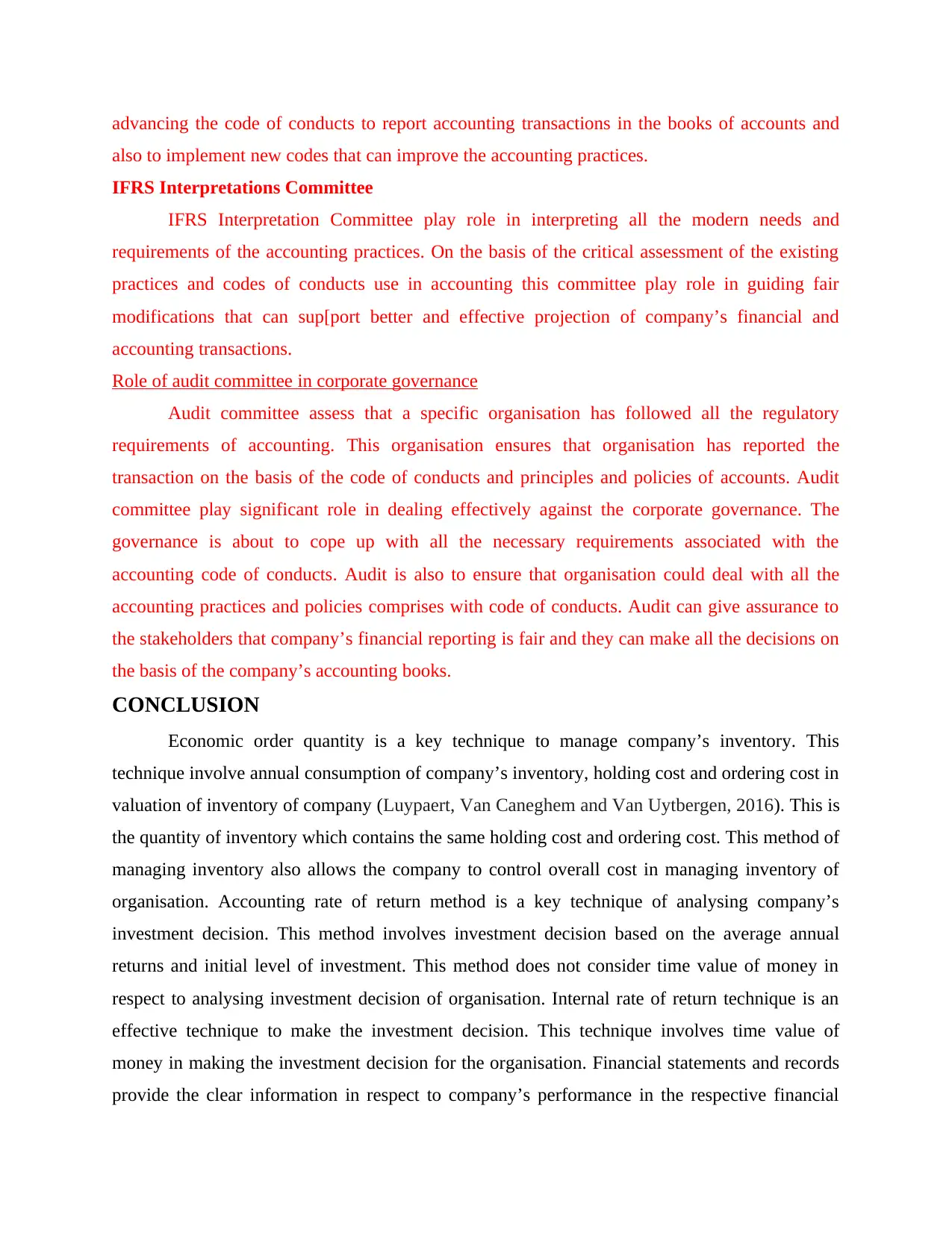
advancing the code of conducts to report accounting transactions in the books of accounts and
also to implement new codes that can improve the accounting practices.
IFRS Interpretations Committee
IFRS Interpretation Committee play role in interpreting all the modern needs and
requirements of the accounting practices. On the basis of the critical assessment of the existing
practices and codes of conducts use in accounting this committee play role in guiding fair
modifications that can sup[port better and effective projection of company’s financial and
accounting transactions.
Role of audit committee in corporate governance
Audit committee assess that a specific organisation has followed all the regulatory
requirements of accounting. This organisation ensures that organisation has reported the
transaction on the basis of the code of conducts and principles and policies of accounts. Audit
committee play significant role in dealing effectively against the corporate governance. The
governance is about to cope up with all the necessary requirements associated with the
accounting code of conducts. Audit is also to ensure that organisation could deal with all the
accounting practices and policies comprises with code of conducts. Audit can give assurance to
the stakeholders that company’s financial reporting is fair and they can make all the decisions on
the basis of the company’s accounting books.
CONCLUSION
Economic order quantity is a key technique to manage company’s inventory. This
technique involve annual consumption of company’s inventory, holding cost and ordering cost in
valuation of inventory of company (Luypaert, Van Caneghem and Van Uytbergen, 2016). This is
the quantity of inventory which contains the same holding cost and ordering cost. This method of
managing inventory also allows the company to control overall cost in managing inventory of
organisation. Accounting rate of return method is a key technique of analysing company’s
investment decision. This method involves investment decision based on the average annual
returns and initial level of investment. This method does not consider time value of money in
respect to analysing investment decision of organisation. Internal rate of return technique is an
effective technique to make the investment decision. This technique involves time value of
money in making the investment decision for the organisation. Financial statements and records
provide the clear information in respect to company’s performance in the respective financial
also to implement new codes that can improve the accounting practices.
IFRS Interpretations Committee
IFRS Interpretation Committee play role in interpreting all the modern needs and
requirements of the accounting practices. On the basis of the critical assessment of the existing
practices and codes of conducts use in accounting this committee play role in guiding fair
modifications that can sup[port better and effective projection of company’s financial and
accounting transactions.
Role of audit committee in corporate governance
Audit committee assess that a specific organisation has followed all the regulatory
requirements of accounting. This organisation ensures that organisation has reported the
transaction on the basis of the code of conducts and principles and policies of accounts. Audit
committee play significant role in dealing effectively against the corporate governance. The
governance is about to cope up with all the necessary requirements associated with the
accounting code of conducts. Audit is also to ensure that organisation could deal with all the
accounting practices and policies comprises with code of conducts. Audit can give assurance to
the stakeholders that company’s financial reporting is fair and they can make all the decisions on
the basis of the company’s accounting books.
CONCLUSION
Economic order quantity is a key technique to manage company’s inventory. This
technique involve annual consumption of company’s inventory, holding cost and ordering cost in
valuation of inventory of company (Luypaert, Van Caneghem and Van Uytbergen, 2016). This is
the quantity of inventory which contains the same holding cost and ordering cost. This method of
managing inventory also allows the company to control overall cost in managing inventory of
organisation. Accounting rate of return method is a key technique of analysing company’s
investment decision. This method involves investment decision based on the average annual
returns and initial level of investment. This method does not consider time value of money in
respect to analysing investment decision of organisation. Internal rate of return technique is an
effective technique to make the investment decision. This technique involves time value of
money in making the investment decision for the organisation. Financial statements and records
provide the clear information in respect to company’s performance in the respective financial
Paraphrase This Document
Need a fresh take? Get an instant paraphrase of this document with our AI Paraphraser
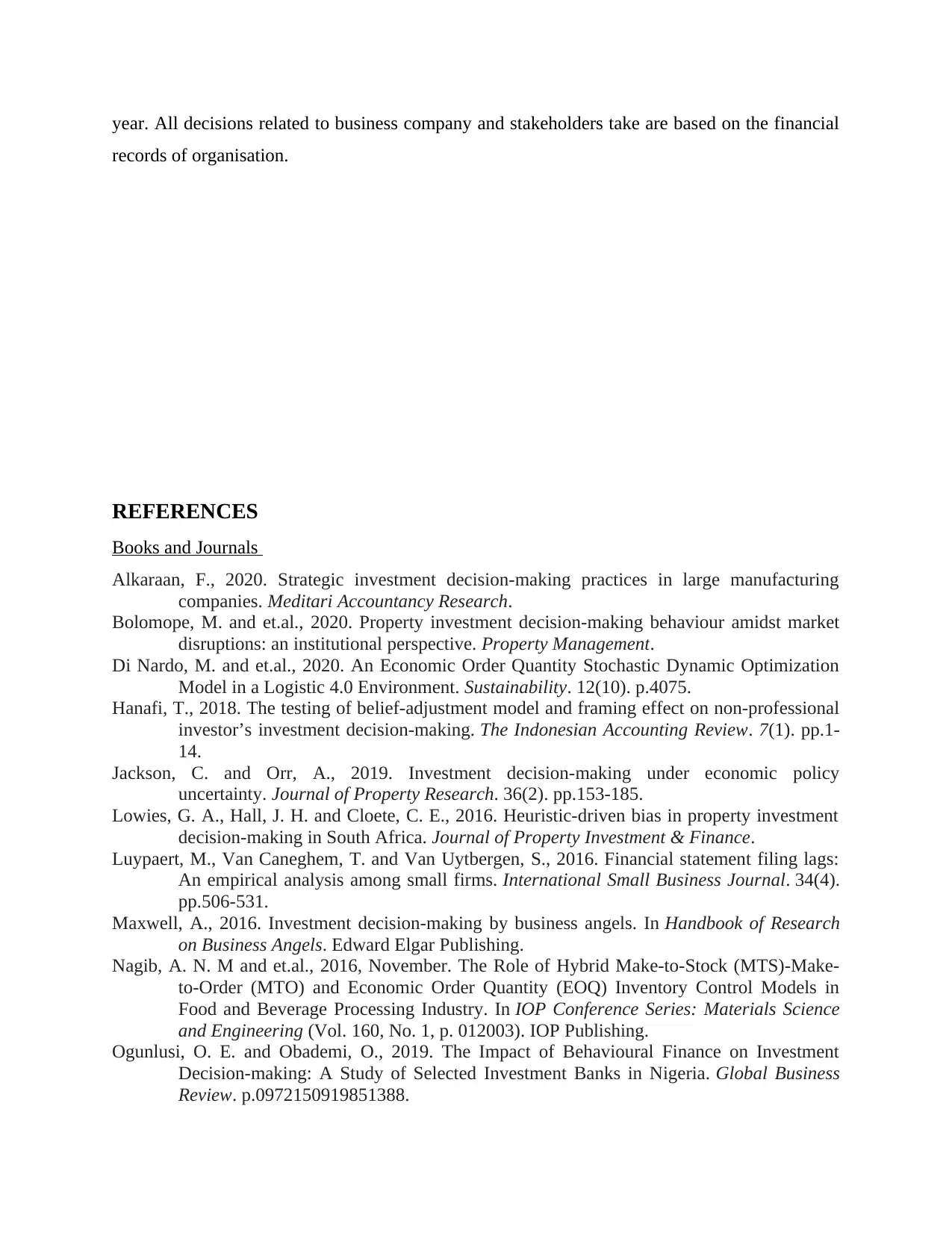
year. All decisions related to business company and stakeholders take are based on the financial
records of organisation.
REFERENCES
Books and Journals
Alkaraan, F., 2020. Strategic investment decision-making practices in large manufacturing
companies. Meditari Accountancy Research.
Bolomope, M. and et.al., 2020. Property investment decision-making behaviour amidst market
disruptions: an institutional perspective. Property Management.
Di Nardo, M. and et.al., 2020. An Economic Order Quantity Stochastic Dynamic Optimization
Model in a Logistic 4.0 Environment. Sustainability. 12(10). p.4075.
Hanafi, T., 2018. The testing of belief-adjustment model and framing effect on non-professional
investor’s investment decision-making. The Indonesian Accounting Review. 7(1). pp.1-
14.
Jackson, C. and Orr, A., 2019. Investment decision-making under economic policy
uncertainty. Journal of Property Research. 36(2). pp.153-185.
Lowies, G. A., Hall, J. H. and Cloete, C. E., 2016. Heuristic-driven bias in property investment
decision-making in South Africa. Journal of Property Investment & Finance.
Luypaert, M., Van Caneghem, T. and Van Uytbergen, S., 2016. Financial statement filing lags:
An empirical analysis among small firms. International Small Business Journal. 34(4).
pp.506-531.
Maxwell, A., 2016. Investment decision-making by business angels. In Handbook of Research
on Business Angels. Edward Elgar Publishing.
Nagib, A. N. M and et.al., 2016, November. The Role of Hybrid Make-to-Stock (MTS)-Make-
to-Order (MTO) and Economic Order Quantity (EOQ) Inventory Control Models in
Food and Beverage Processing Industry. In IOP Conference Series: Materials Science
and Engineering (Vol. 160, No. 1, p. 012003). IOP Publishing.
Ogunlusi, O. E. and Obademi, O., 2019. The Impact of Behavioural Finance on Investment
Decision-making: A Study of Selected Investment Banks in Nigeria. Global Business
Review. p.0972150919851388.
records of organisation.
REFERENCES
Books and Journals
Alkaraan, F., 2020. Strategic investment decision-making practices in large manufacturing
companies. Meditari Accountancy Research.
Bolomope, M. and et.al., 2020. Property investment decision-making behaviour amidst market
disruptions: an institutional perspective. Property Management.
Di Nardo, M. and et.al., 2020. An Economic Order Quantity Stochastic Dynamic Optimization
Model in a Logistic 4.0 Environment. Sustainability. 12(10). p.4075.
Hanafi, T., 2018. The testing of belief-adjustment model and framing effect on non-professional
investor’s investment decision-making. The Indonesian Accounting Review. 7(1). pp.1-
14.
Jackson, C. and Orr, A., 2019. Investment decision-making under economic policy
uncertainty. Journal of Property Research. 36(2). pp.153-185.
Lowies, G. A., Hall, J. H. and Cloete, C. E., 2016. Heuristic-driven bias in property investment
decision-making in South Africa. Journal of Property Investment & Finance.
Luypaert, M., Van Caneghem, T. and Van Uytbergen, S., 2016. Financial statement filing lags:
An empirical analysis among small firms. International Small Business Journal. 34(4).
pp.506-531.
Maxwell, A., 2016. Investment decision-making by business angels. In Handbook of Research
on Business Angels. Edward Elgar Publishing.
Nagib, A. N. M and et.al., 2016, November. The Role of Hybrid Make-to-Stock (MTS)-Make-
to-Order (MTO) and Economic Order Quantity (EOQ) Inventory Control Models in
Food and Beverage Processing Industry. In IOP Conference Series: Materials Science
and Engineering (Vol. 160, No. 1, p. 012003). IOP Publishing.
Ogunlusi, O. E. and Obademi, O., 2019. The Impact of Behavioural Finance on Investment
Decision-making: A Study of Selected Investment Banks in Nigeria. Global Business
Review. p.0972150919851388.
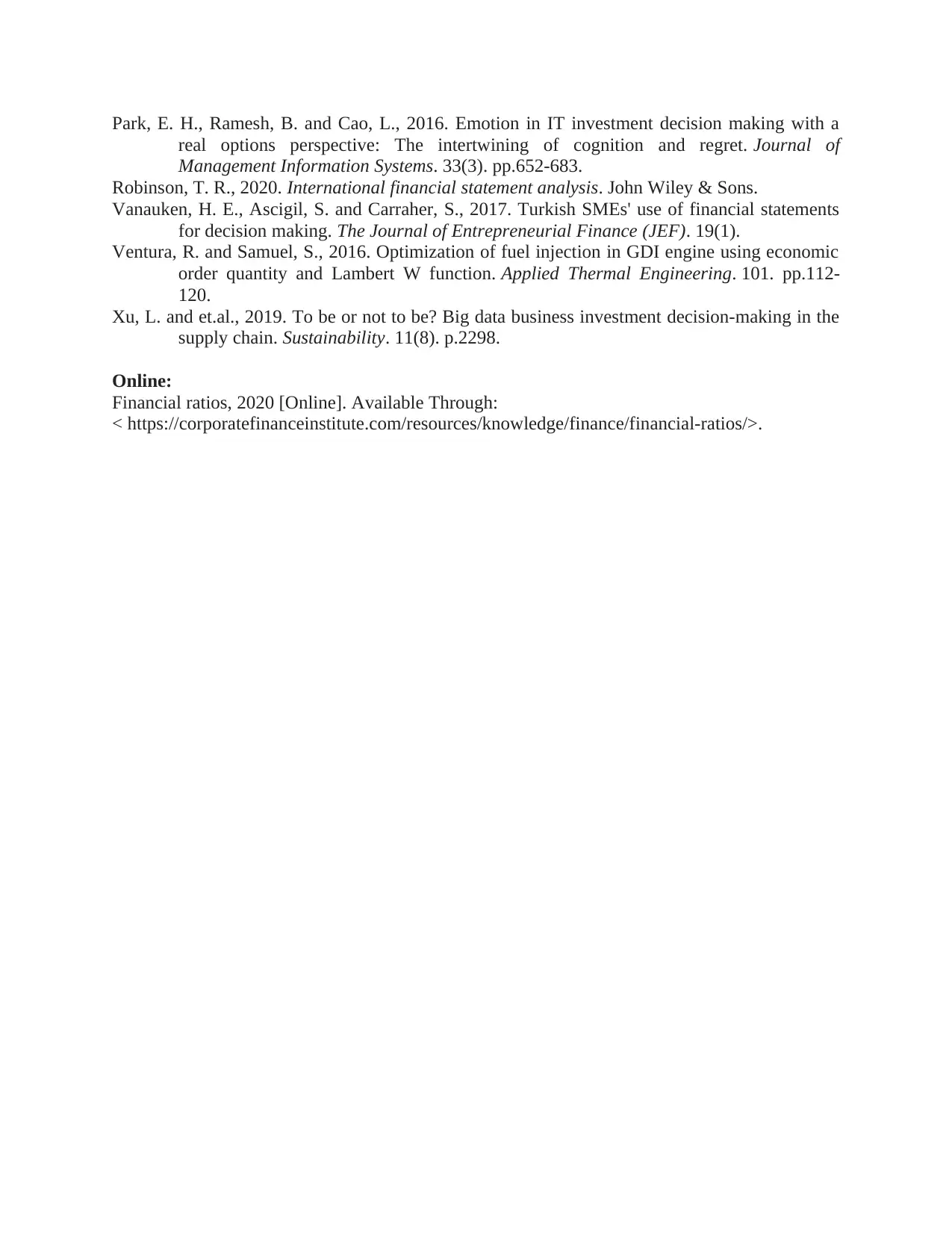
Park, E. H., Ramesh, B. and Cao, L., 2016. Emotion in IT investment decision making with a
real options perspective: The intertwining of cognition and regret. Journal of
Management Information Systems. 33(3). pp.652-683.
Robinson, T. R., 2020. International financial statement analysis. John Wiley & Sons.
Vanauken, H. E., Ascigil, S. and Carraher, S., 2017. Turkish SMEs' use of financial statements
for decision making. The Journal of Entrepreneurial Finance (JEF). 19(1).
Ventura, R. and Samuel, S., 2016. Optimization of fuel injection in GDI engine using economic
order quantity and Lambert W function. Applied Thermal Engineering. 101. pp.112-
120.
Xu, L. and et.al., 2019. To be or not to be? Big data business investment decision-making in the
supply chain. Sustainability. 11(8). p.2298.
Online:
Financial ratios, 2020 [Online]. Available Through:
< https://corporatefinanceinstitute.com/resources/knowledge/finance/financial-ratios/>.
real options perspective: The intertwining of cognition and regret. Journal of
Management Information Systems. 33(3). pp.652-683.
Robinson, T. R., 2020. International financial statement analysis. John Wiley & Sons.
Vanauken, H. E., Ascigil, S. and Carraher, S., 2017. Turkish SMEs' use of financial statements
for decision making. The Journal of Entrepreneurial Finance (JEF). 19(1).
Ventura, R. and Samuel, S., 2016. Optimization of fuel injection in GDI engine using economic
order quantity and Lambert W function. Applied Thermal Engineering. 101. pp.112-
120.
Xu, L. and et.al., 2019. To be or not to be? Big data business investment decision-making in the
supply chain. Sustainability. 11(8). p.2298.
Online:
Financial ratios, 2020 [Online]. Available Through:
< https://corporatefinanceinstitute.com/resources/knowledge/finance/financial-ratios/>.
⊘ This is a preview!⊘
Do you want full access?
Subscribe today to unlock all pages.

Trusted by 1+ million students worldwide
1 out of 15
Related Documents
Your All-in-One AI-Powered Toolkit for Academic Success.
+13062052269
info@desklib.com
Available 24*7 on WhatsApp / Email
![[object Object]](/_next/static/media/star-bottom.7253800d.svg)
Unlock your academic potential
© 2024 | Zucol Services PVT LTD | All rights reserved.




